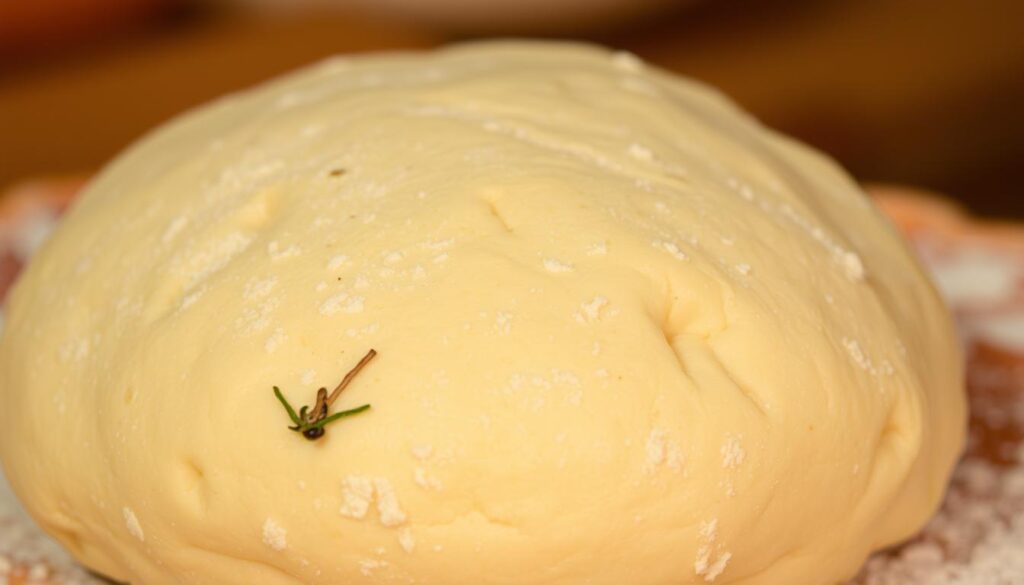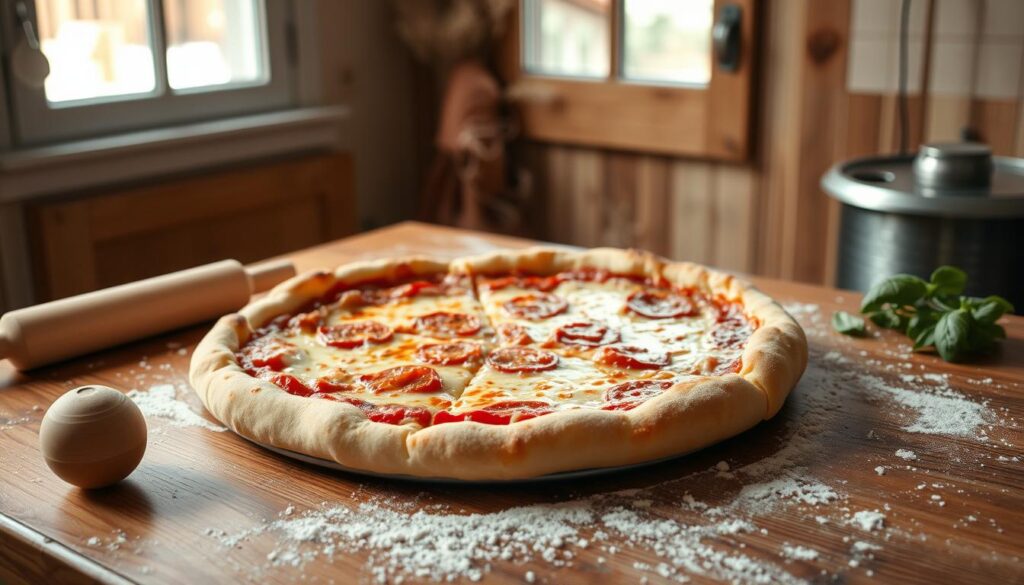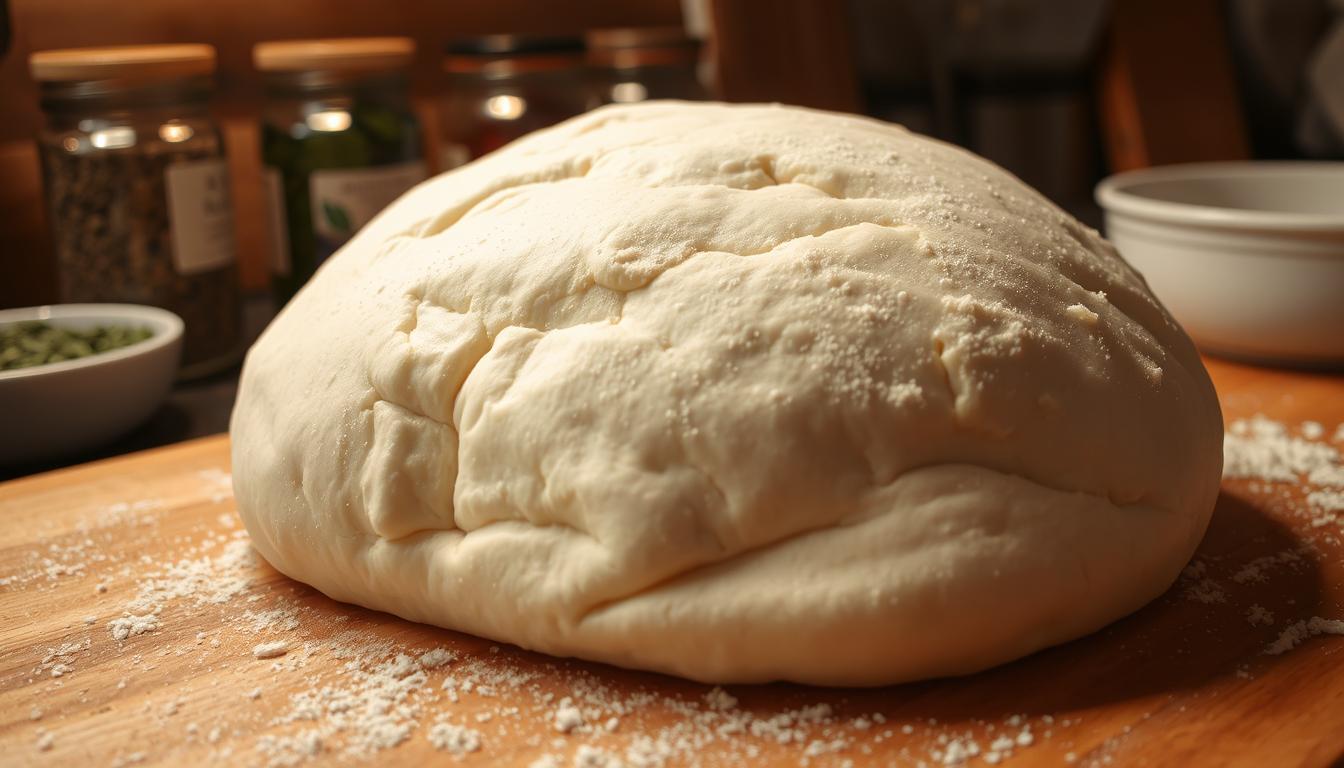Homemade Pizza Dough: The Perfect Base for Your Pie
Making pizza dough from scratch is a game-changer for anyone who loves a good pie. Not only does it allow for customization of ingredients and flavors, but it also ensures a freshness that’s hard to achieve with store-bought dough.
With a simple pizza dough recipe, you can create a delicious base for your favorite toppings. The process of making homemade pizza dough is straightforward and rewarding, making it a great activity for the whole family.
Key Takeaways
- Learn the basics of making pizza dough from scratch.
- Discover the benefits of homemade pizza dough.
- Find a simple pizza dough recipe to try at home.
- Understand the importance of ingredients in pizza making.
- Get tips for customizing your pizza dough.
The Science Behind Perfect Pizza Dough
The art of making pizza dough is rooted in science, where the perfect blend of ingredients and conditions creates a culinary masterpiece. To achieve the perfect crust, it’s essential to understand the underlying processes that govern pizza dough preparation.
Understanding Gluten Development
Gluten development is a critical factor in pizza dough, as it determines the dough’s texture and structure. Gluten is a network of proteins that forms when flour is mixed with water. The more the dough is kneaded, the more developed the gluten becomes, leading to a chewier crust. However, overworking the dough can result in a tough, dense crust.
The Role of Fermentation
Fermentation is another crucial aspect of pizza dough preparation. It’s the process by which yeast converts sugars into carbon dioxide, causing the dough to rise. This process not only affects the texture but also contributes to the flavor of the crust. A longer fermentation time can lead to a more complex flavor profile.
Why Temperature Matters
Temperature control is vital during the dough preparation process. Yeast activity is highly temperature-dependent, with optimal temperatures ranging between 75°F and 80°F (24°C to 27°C). Temperature affects not only the rate of fermentation but also the final texture and flavor of the crust.
| Temperature (°F) | Yeast Activity | Effect on Crust |
|---|---|---|
| 75-80 | Optimal | Complex flavor, good texture |
| Below 75 | Slow | Less flavorful, dense |
| Above 80 | Fast | Over-proofed, soggy |
By understanding and controlling these factors, you can create a pizza dough that is both delicious and visually appealing.
Essential Ingredients for Homemade Pizza Dough
Creating the perfect homemade pizza dough starts with understanding the essential ingredients that make it rise to the occasion. The quality and type of ingredients used can significantly affect the flavor, texture, and overall success of your pizza dough.
Flour Options and Their Effects
The type of flour used is crucial in determining the texture and flavor of your pizza dough. All-purpose flour is a popular choice due to its balanced protein content, which typically ranges between 10% to 12%. This balance provides structure without making the dough too chewy or too dense.
For a more authentic Neapolitan-style pizza, Caputo flour is often recommended due to its low protein content and fine texture. On the other hand, bread flour with a higher protein content (12% to 14%) can produce a chewier crust, ideal for those who prefer a more rustic texture.
| Flour Type | Protein Content | Best For |
|---|---|---|
| All-purpose Flour | 10%-12% | General pizza dough |
| Caputo Flour | 9%-11% | Neapolitan-style pizza |
| Bread Flour | 12%-14% | Chewy, rustic crust |
Yeast Types: Active Dry vs. Instant
Yeast is a critical ingredient that makes the dough rise. There are two main types of yeast: active dry yeast and instant yeast. Active dry yeast needs to be rehydrated before use, while instant yeast can be mixed directly into the dry ingredients.
According to
“The Bread Baker’s Apprentice”
by Peter Reinhart, instant yeast is more potent and can produce faster results, but both types can yield excellent outcomes if used correctly.
The Importance of Salt and Sugar
Salt not only adds flavor but also controls yeast growth, strengthening the dough’s structure. Sugar, on the other hand, feeds the yeast, promoting fermentation. A balanced amount of salt and sugar is crucial for achieving the right flavor and texture.
Water Temperature and Quality
The temperature and quality of water used can significantly impact the dough. Water that is too hot can kill the yeast, while water that is too cold can slow down fermentation. Ideally, the water should be between 90°F and 100°F for most yeast types.
Optional Ingredients for Enhanced Flavor
Optional ingredients like herbs, spices, and specialty oils can be added to enhance the flavor of your pizza dough. For instance, adding a bit of olive oil can improve the dough’s texture and taste.
Tools and Equipment You’ll Need
The right equipment can make a significant difference in the quality of your homemade pizza dough. To get started, you’ll need a few essential tools and equipment that will help you mix, knead, proof, and bake your dough to perfection.
Mixing and Kneading Tools
A large mixing bowl is necessary for combining your ingredients. You can use either a stand mixer with a dough hook attachment or a wooden spoon and a large bowl for manual mixing. For kneading, a lightly floured surface or a stand mixer with a dough hook is ideal.
Proofing Containers
A lightly oiled bowl covered with plastic wrap or a damp towel is essential for proofing your dough. You can also use a proofing basket or a warm, draft-free place to let your dough rise.
Baking Surfaces and Their Impact
A baking stone or a baking steel can enhance the crust of your pizza by distributing heat evenly. Alternatively, you can use a regular baking sheet.
Measuring Tools for Accuracy
Accurate measuring cups and digital scales are crucial for measuring your ingredients precisely, ensuring consistent results.
Step-by-Step Homemade Pizza Dough Recipe
Making homemade pizza dough from scratch is a straightforward process that requires just a few ingredients and some patience. With this recipe, you’ll be able to create a delicious and authentic Italian-style pizza crust that’s sure to impress your family and friends.
Mixing the Ingredients
To start, combine 2 cups of warm water, 2 teaspoons of sugar, and 1 teaspoon of active dry yeast in a large mixing bowl. Let the mixture sit for 5-10 minutes, or until the yeast becomes frothy and bubbly. Then, add 3 cups of all-purpose flour, 1 teaspoon of salt, and 2 tablespoons of olive oil to the bowl. Mix the ingredients together until a shaggy dough forms.
Kneading Techniques
Turn the dough out onto a floured surface and knead for 5-10 minutes, or until the dough becomes smooth and elastic. You can also use a stand mixer with a dough hook attachment to knead the dough. Proper kneading is essential for developing the gluten in the dough, which will give your crust its signature chewiness.
First Rise: Signs of Proper Fermentation
Place the dough in a lightly oiled bowl, cover it with plastic wrap, and let it rise in a warm, draft-free place for 1-2 hours, or until it has doubled in size. Check for signs of proper fermentation, such as bubbles on the surface and a slightly sour smell. This step is crucial for developing the flavor and texture of your crust.
Punching Down and Shaping
Once the dough has risen, punch it down to release any air bubbles. Then, divide the dough into 2-4 equal portions, depending on the size of pizza you want to make. Shape each portion into a ball and then flatten it into a disk using your hands or a rolling pin.
Second Rise and Final Preparation
Let the shaped dough rise for another 30-60 minutes, or until it has relaxed and become easier to shape. Then, top your pizza with your favorite ingredients and bake it in a preheated oven at 450-500°F (230-260°C) for 12-15 minutes, or until the crust is golden brown and the toppings are cooked through.
Common Pizza Dough Mistakes and How to Avoid Them
The journey to perfect homemade pizza dough is often marred by mistakes that can be easily avoided with the right knowledge. Understanding these common pitfalls is crucial for achieving that perfect crust.
Overworking vs. Underworking the Dough
One of the most common pizza dough mistakes is overworking or underworking the dough. Overworking can lead to a tough, dense crust because it develops too much gluten. On the other hand, underworking the dough might result in a crust that lacks structure and is too soft. The key is to knead just enough to develop the gluten sufficiently without overdoing it.
As Peter Reinhart, a renowned bread expert, suggests, “The dough should be kneaded until it becomes smooth and elastic, but still retain a certain softness.” This balance is crucial for a crust that’s both crispy and chewy.
Temperature Problems
Temperature plays a significant role in making pizza dough. If the ingredients are too cold, the yeast won’t activate properly, slowing down the fermentation process. Conversely, if it’s too hot, the yeast can over-ferment, leading to an unpleasant flavor. Ensuring that your ingredients are at room temperature can help mitigate these temperature issues.
Yeast Troubleshooting
Yeast problems are another common issue. If your dough isn’t rising, it could be due to expired yeast, incorrect temperature, or insufficient sugar to feed the yeast. Always check the expiration date of your yeast and ensure your water is not too hot or cold.
“Yeast is a living organism and needs the right conditions to thrive,” notes a leading baking expert.
Fixing Sticky or Dry Dough
Dealing with dough that’s either too sticky or too dry is a frequent challenge. For sticky dough, gradually add a bit more flour until it reaches the right consistency. For dry dough, a small amount of water can help. The goal is to achieve a dough that’s smooth and slightly tacky but not sticky.
By understanding and avoiding these common pizza dough mistakes, you’ll be well on your way to creating a delicious homemade pizza with a perfect crust.
Enhancing Your Homemade Pizza Dough with Flavors
Transforming your pizza dough into a flavor sensation is easier than you think. By incorporating various ingredients, you can create a unique and delicious base for your pizzas.
Herbs and Spices to Consider
Adding herbs and spices is a simple way to infuse your dough with flavor. Consider using oregano, basil, or rosemary for a classic Italian taste. For a bit of heat, add some red pepper flakes or garlic powder. You can also experiment with smoked paprika or garam masala for a more exotic flavor profile.

Garlic and Cheese Infusions
For those who love a strong garlic flavor, making a garlic-infused oil to mix into your dough can be a game-changer. Alternatively, you can directly add minced garlic to the dough. Cheese infusion is another great option; try adding grated Parmesan or mozzarella to give your crust an extra burst of flavor.
Specialty Oils and Their Effects
Using different oils can significantly impact the flavor of your dough. Olive oil is a classic choice, but you can also experiment with truffle oil for a luxurious taste or avocado oil for a mild, buttery flavor. Each oil brings its unique characteristics to the dough, so feel free to mix and match to find your perfect blend.
Sweet Dough Variations
For a dessert pizza or a sweet treat, consider making a sweet dough. You can achieve this by adding sugar, honey, or even cinnamon to your dough. Sweet dough pairs well with fruit toppings or can be enjoyed on its own as a sweet bread.
Different Pizza Dough Styles Around the World
From the classic thin crusts of New York to the deep-dish pies of Chicago, pizza dough styles are as diverse as they are delicious. This diversity reflects local tastes, traditions, and ingredients, making pizza a rich culinary experience worldwide.
New York-Style Thin Crust
New York-style pizza is known for its thin crust that is hand-tossed and crispy. It’s made with a simple dough of flour, water, yeast, and salt, and is cooked in a brick oven. The result is a crust that is crunchy on the outside and chewy on the inside.
Chicago Deep Dish Foundations
Chicago deep-dish pizza has a thick crust formed into a deep pan and topped with a thick layer of cheese, meats, and vegetables. The crust is flaky and buttery, formed by layering butter and dough.
Neapolitan Traditional Method
Neapolitan pizza is characterized by a soft, chewy crust with a charred edge, cooked in a wood-fired oven. The dough is made with Type “00” flour, water, salt, and yeast, and is topped with simple ingredients like tomato, mozzarella, and basil.
Sicilian and Focaccia-Style Bases
Sicilian pizza, also known as “sfincione,” has a thick, square crust that is rich and spongy. It’s often topped with a thick layer of tomato sauce, cheese, and various meats or anchovies. Focaccia-style pizza is similar but tends to be more rectangular and may be topped with olive oil, herbs, and sometimes cheese.
California-Style Innovations
California-style pizza is known for its non-traditional toppings and flavor combinations, reflecting the state’s cultural diversity. The crust can vary from thin to thick and is often made with artisanal flours and ingredients.
| Pizza Style | Crust Characteristics | Typical Toppings |
|---|---|---|
| New York-Style | Thin, crispy, hand-tossed | Classic mozzarella, pepperoni, sausage |
| Chicago Deep Dish | Thick, flaky, buttery | Thick layer of cheese, meats, vegetables |
| Neapolitan | Soft, chewy, charred edge | Tomato, mozzarella, basil |
| Sicilian | Thick, square, spongy | Thick tomato sauce, cheese, meats or anchovies |
| California-Style | Varies, artisanal flours | Non-traditional, diverse toppings |
From Dough to Delicious: Baking the Perfect Pizza
To turn your homemade dough into a delicious pizza, you need to master the baking process. Baking a pizza is a culmination of all the previous steps, from mixing the dough to topping it with your favorite ingredients.
Preheating Strategies for Different Ovens
Preheating your oven is crucial for achieving a crispy crust. For conventional ovens, preheat to 450°F (230°C) with a baking stone inside, if you have one. For pizza stones or baking steels, preheat for at least 30 minutes to ensure they’re hot. If you’re using a pizza oven or a grill with a pizza stone, follow the manufacturer’s guidelines for preheating.

Stretching and Shaping Techniques
Stretching and shaping your dough is an art that requires some practice. Start by gently stretching the dough from the center outwards, working your way around the circle. Use your hands to shape it into a perfect circle or rectangle, depending on your preference. Make sure the dough is evenly thick to prevent uneven cooking.
Topping Your Pizza Without Sogging the Crust
The key to avoiding a soggy crust is to balance your toppings. Too many toppings or too much sauce can make the crust soggy. Use a moderate amount of sauce, cheese, and toppings. Consider pre-cooking ingredients like mushrooms or spinach to remove excess moisture before adding them to your pizza.
Baking Times and Temperatures
Baking times and temperatures can vary depending on your oven and the thickness of your crust. Generally, a thin crust pizza bakes at a higher temperature (around 500°F or 260°C) for a shorter time (10-12 minutes). Thicker crusts may require a lower temperature (around 425°F or 220°C) for a longer period (15-20 minutes). Keep an eye on your pizza to ensure it doesn’t overcook.
By mastering these baking techniques, you’ll be able to create delicious homemade pizzas that rival those from your favorite pizzeria.
Make-Ahead and Storage Tips for Pizza Dough
To make the most of your homemade pizza dough, understanding storage options is key. Proper storage allows you to plan meals ahead, save time, and reduce waste.
Refrigeration Methods
Refrigerating your pizza dough is a great way to slow down the fermentation process. To do this effectively, place the dough in an airtight container or a zip-top plastic bag, making sure to remove as much air as possible before sealing. This method can keep your dough fresh for up to 3 days.
Freezing and Thawing Properly
For longer storage, freezing is an excellent option. Divide the dough into portions, shape them into balls, and wrap each tightly in plastic wrap or aluminum foil. Place the wrapped dough balls in a freezer-safe bag or container. When you’re ready to use the dough, thaw it overnight in the refrigerator or at room temperature for a few hours.
How to Tell If Your Dough Has Gone Bad
Check your dough regularly for signs of spoilage. If it has an off smell, visible mold, or a slimy texture, it’s time to discard it. Overly fermented dough may also collapse or have large bubbles, indicating it’s past its prime.
Reviving Older Dough
If your dough is nearing the end of its storage life, you can sometimes revive it. Gently punch down the dough to redistribute the yeast, then let it rest for a few hours before shaping. This can help restore some of its original vitality.
| Storage Method | Duration | Tips |
|---|---|---|
| Refrigeration | Up to 3 days | Use airtight containers or zip-top bags. |
| Freezing | Up to 3 months | Divide into portions, wrap tightly, and store in freezer-safe bags. |
Conclusion: Mastering the Art of Homemade Pizza Dough
Mastering pizza dough is a journey that requires patience, practice, and a willingness to experiment. By understanding the science behind perfect pizza dough, using essential ingredients, and avoiding common mistakes, you can achieve homemade pizza perfection. As you’ve learned, the right techniques, from mixing to baking, play a crucial role in creating a delicious crust.
Continuing to try different ingredients and styles will help you refine your skills. Whether you’re making a classic Neapolitan-style pizza or a California-style innovation, the key to success lies in the quality of your dough. With time and practice, you’ll be crafting pizzas that rival your favorite pizzeria.







